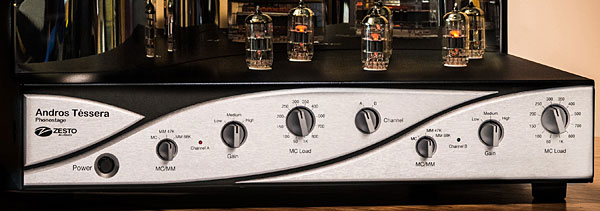| Columns Retired Columns & Blogs |
Zesto Audio Andros Téssera phono preamplifier Page 2
While the usual way to start listening to a new audio component is to play familiar recordings, I thought it might be more interesting to start with an unfamiliar record. Les liaisons dangereuses 1960, Thelonious Monk's previously unreleased music for Roger Vadim's film Les liaisons dangereuses (2 180gm LPs, Sam 5 051083 116923), had just arrived, and I was anxious to hear this newly discovered Monk!
Would I be judging the record's sound or the Téssera's? No way of knowing until I played the same album through a reference phono preamp. But Tom Nola had recorded the session on July 27, 1959, at Nola Penthouse Sound Studios, where many familiar jazz records of that era were recorded, and I know the house sound.
Had I reviewed the album's sound quality based on that first hearing through the Andros Téssera, I'd have written that Sam Jones's bass was somewhat soft and loose but well textured; that Charlie Rouse's and Barney Wilen's saxes sounded wet, pleasingly reedy, and luscious, but softer than expected; that Art Taylor's cymbals were somewhat soft but beautifully textured, and his snare also somewhat soft but harmonically expressive; and that Monk's piano had soft attacks, too-generous sustain, and uncharacteristically long decays. The piano didn't sound underwater, but it was murky.

After again playing side 1 through another tubed phono stage, the far more expensive Ypsilon VPS-100 Silver Edition ($65,000) with MC-16L step-up transformer ($2800), I concluded that what I've just described was an exaggerated version of this recording's actual sound—which, while very good, isn't quite up to the quality of the best from the Nola Penthouse, at least those I've heard that were mastered when the tapes were fresher.
Out of the box, the Andros Téssera produced luscious mids that immediately dominated the music, producing in that region a glorious, golden, airy sound reminiscent of my old Dynaco PAS-3X preamp (which I stupidly sold to buy a PAT-4), while the top was simultaneously a bit soft and glassy, even with my Lyra Atlas SL cartridge loaded at 50 ohms. The bottom was somewhat flabby—bigger and longer-lasting than it should have been.
I'd played test pressings of Bloodlines, a boxed set comprising the first four albums by Blood, Sweat & Tears (8 45rpm LPs, Columbia/Legacy/Analogue Productions APP BSTBOX-45), through both the Ypsilon VPS-100/MC-16L and CH Precision P1/X1 that I wrote about in the April and June issues, and had gotten a good handle on the sound of Ryan K. Smith's remastering, at Sterling Sound, from the original tapes: ultra-transparent, superdetailed, forceful, fully extended on bottom, and a bit forward in the presence region (as are most Smith remasterings).
Despite the cackling and goofy stuff, my favorite BS&T album is still their first, Child Is Father to the Man, with Al Kooper. I'd thought my 1A original pressing was unbeatable, but this reissue kills it in every way, revealing heretofore hidden musical details, and delivering, with far greater precision and dynamic thrust, what was always out front in the mix. At first, the still relatively un-broken-in Téssera's rendering added unwanted glare to the horns while slobbering over the bass lines—the same colorations I'd heard with the Monk album.
But by the time a finished copy of the BS&T set had arrived, the Téssera was fully broken in and sitting on the Stillpoints. I gave Child Is Father to the Man another spin. The glare was gone, the bottom end had tightened considerably, and, thankfully, the addictive midrange remained.
Which was what I'd expected to hear. Once the Téssera had settled in, everything I played sounded "right" within the context of how a properly designed and tricked-out, 12AX7-based phono preamp should sound: fully extended on top, with precise, finely focused transients and an abundance of air; rich, even voluptuous mids; and a generous, fully expressed bottom end that fit well with the mids, but was hardly the last word in terms of grip, authority, and punch—although, overall, dynamics were very good, helped by the low noise floor. In short, the Andros Téssera traded bottom-end authority and grippy bass for the fully developed textures and sonorous midrange that even the best solid-state designs somewhat lose track of.
I then compared two pressings of Venice, with Georg Solti conducting the Orchestra of the Royal Opera House Convent Garden in instrumental music from various Italian operas: an original (LP, RCA Living Stereo LSC-2313) and a reissue (200gm LP, Analogue Productions AAPC 2313). Instead of obscuring the differences between them under a blanket of tube warmth, the Téssera made them clear. On the RCA, engineered by Kenneth Wilkinson at Kingsway Hall and originally recorded for UK Decca, the strings are to melt from; on the reissue, they're somewhat drier and less effusive, though more detailed. The Téssera let me hear those differences, but compared to the Ypsilon or the CH Precision, it also exacerbated the recording's problematic bass.
Summing Up
The Andros Téssera's less than fully controlled, somewhat larger-than-life bottom end was its only less-than-stellar attribute. This is something it shares with tubed phono preamps in general, though whether or not it will be a problem for you will depend on the extension and quality of your speakers' bass, and the kind of music you listen to. Acoustic music, particularly jazz and classical, thrived in the Andros Téssera's hands; hard rock did somewhat less well. As with any audio component, your reaction to it will depend on what you're willing to give up. There are always tradeoffs.
That said, I stand by what I wrote about Zesto Audio's Andros PS1—and, for its overall finesse and host of attractive sonic qualities, what I can now say about the Andros Téssera: it's "among the more enjoyable and satisfying phono preamplifiers I've auditioned at any price."
- Log in or register to post comments




































